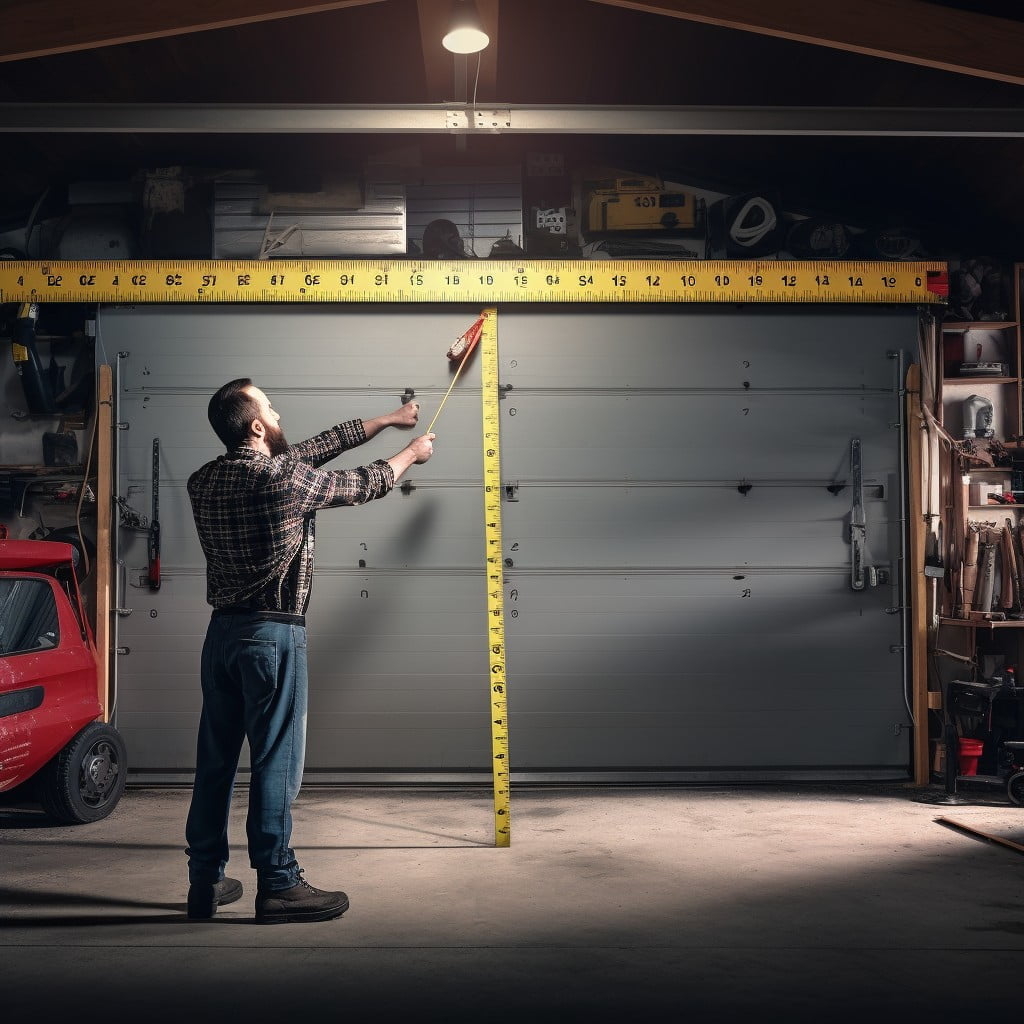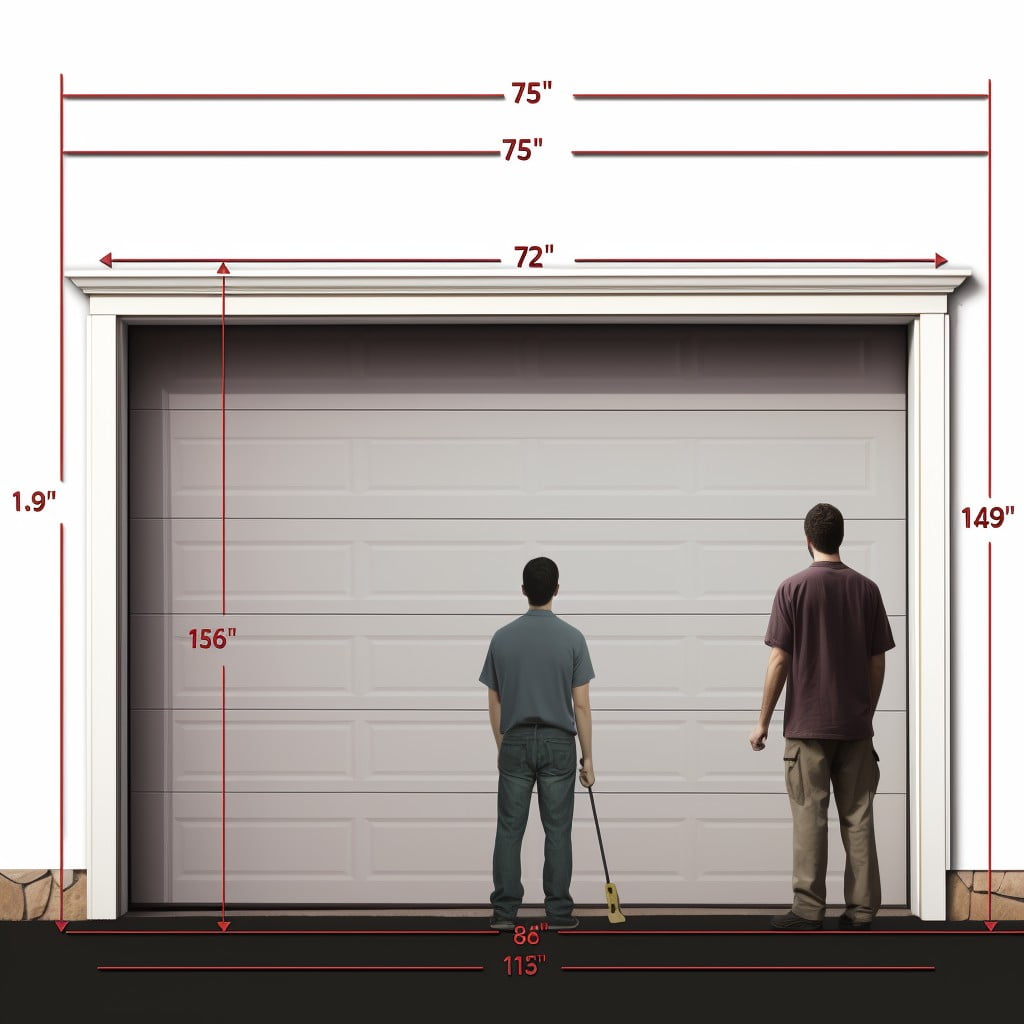Understanding the correct method to measure your garage door is a crucial step in ensuring an efficient installation and perfect fit.
Measuring a garage door is a simple yet crucial task that ensures the perfect fit for your garage. This process involves determining the width, height, and side room, as well as the headroom and backroom of the garage opening. With the right tools and a step-by-step approach, you can accurately measure your garage door.
This article provides a comprehensive guide on how to carry out these measurements, ensuring you get the correct garage door size for a seamless installation. From the tools you’ll need, to the pitfalls to avoid, we’ve got all the details covered.
Key takeaways:
- Recognize the major components of a garage door.
- Use a steel tape measure and double-check measurements.
- Take assistance for accurate measurements of larger doors.
- Ignore existing weatherstripping when measuring width and height.
- Troubleshoot common measurement issues and consider headroom.
Understanding the Different Parts of Your Garage Door

To ensure a successful measuring process, it’s crucial to be familiar with the basic components of the garage door. Here are the major elements to consider:
1. Panels: These are the large, flat pieces that make up most of the door’s surface. The number of panels can vary, usually ranging from one to four.
2. Rails and Stiles: These are the supporting structures that hold the panels in place. Rails are horizontal, running from side to side, while stiles are vertical, running top to bottom.
3. Torsion Spring: Located above the door when it’s closed, this spring helps lift the garage door by counterbalancing the weight of the door.
4. Tracks: These guide the door as it opens and closes. Located on both sides of the door, they house the rollers that allow the door to move.
5. Weather Stripping: Found along the bottom edge of the door, it seals the gap between the door and the floor when the door is closed to prevent air leakage.
Recognizing these elements will not only assist in obtaining accurate measurements, but also in diagnosing potential issues that may arise during or after the installation process.
Tools Needed to Measure a Garage Door

To ensure an accurate measurement of your garage door, several tools come in handy. A metal tape measure often proves to be the most effective because of its robustness and accuracy. Unlike cloth or plastic, metal tape measures do not fray or stretch, delivering precise results.
Additionally, a step ladder is useful, particularly for measuring the garage door’s height. Safety should always be a priority, therefore choose a stable, well-constructed step ladder.
Lastly, you may need a helper. While not exactly a tool, an extra pair of hands can make the process a lot easier — especially when handling the tape measure or climbing the ladder. With these items at your disposal, the process should be efficient and precise.
Creating a Step-by-Step Plan to Measure Your Garage Door

Begin by gathering all the necessary tools, such as a tape measure, notepad, and a pen or pencil for jotting down the measurements. Next, measure the width of the door by extending your tape measure across the door’s bottom, from one end to the other. Record this measurement, as it represents the door’s width.
Move on to assessing the door’s height, followed by thickness. In both cases, place the head of your tape measure at the top of the door and extend it down or through, respectively, writing down the figures you get. Remember to measure from the inside of the tracks for a more accurate width. Always take each measurement twice to ensure accuracy.
Bear in mind that measuring single doors will be relatively straightforward, while double garage doors may present a bit more of a challenge, as you’ll need to factor in the center post in addition to measuring each door separately. If your garage door has any kind of irregular shape, consider breaking your measurements down into sections for greater precision. Finally, don’t forget to document all measurements, even if they seem small – every bit of information can be crucial when choosing the right door size.
Measuring a Garage Door: Width and Height

Using a measuring tape, measure the width from the middle of your garage door. Start from the left side, extending to the right. Ensure the tape reaches the widest point, normally from one end of the frame to the other. Width measurements are always listed first.
Next, calculate the height. By the same principle, measure from the top of the door to the bottom at the centre. It’s important to measure from the floor to the highest point of the opening, to ensure there is adequate clearance. Be sure to take note of any irregularities or obstructions such as lighting fixtures, pipes, or tracks.
Typically, standard residential garage door widths are in increments of 2 feet, from 8 feet to 18 feet, while the height commonly ranges from 7 to 8 feet. However, custom-made doors may differ. Always double-check your measurements for precision and accuracy. Misreading measurements can lead to ordering the wrong door size, causing extra expenses and delays.
How to Measure Garage Door Thickness
Capturing the thickness of your garage door can initially appear as a complex task, but by following these simple instructions, it becomes an achievable mission. Your first step should be to locate an edge of your garage door, preferably an area where the insulation is visible.
Next, grab a reliable tape measure. Place the end of the tape measure at the widest point of your garage door and extend it across the depth, right to the back of the door. Be sure to account for any layers of insulation or weatherstripping, as these can contribute significantly to the overall thickness.
Remember to keep the tape measure as straight as possible. Angling it can lead to inaccurate readings. Repeat this process in a few different spots on your garage door to ensure consistency.
For precision, it is recommended to measure in millimeters, as garage doors can have quite slim variations in thickness. However, converting millimeter measurements to inches can provide a more familiar frame of reference if needed. A standard garage door usually measures between 1 3/8 inches to 2 inches in thickness.
If you encounter any difficulties while measuring, don’t hesitate to consult with a garage door professional. They can provide you with essential tips and tricks to aid your measurement process.
Tips for Accurate Garage Door Measurement
It’s essential to maintain precision when taking measurements, as every inch matters in ensuring a perfect fit. Several tips can help you achieve this:
- Use a steel measuring tape: For accuracy, opt for a steel measuring tape. Unlike cloth or plastic tapes, steel ones don’t stretch or deform.
- Double-check measurements: Even experienced measurers can make mistakes. It’s good practice to measure twice or even thrice to confirm your findings.
- Take assistance: Measurement can be tricky for larger doors, thus having someone at hand can make the process smoother.
- Ignore existing weatherstripping: While measuring the width and height, the existing weatherstripping or seal should not be included.
- Note down measurements: Always note down the measurements immediately to avoid forgetting or mixing them up.
Employ these tips to ensure your garage door measurements are precise and accurate. Remember, the correct measurements are the key to a well-fitting garage door that functions efficiently.
Troubleshooting Common Measurement Issues for Garage Doors
The occasional hiccup in measuring a garage door is not uncommon. Here are a few common issues you may encounter and practical solutions for each:
1. Inconsistency in readings: If you’re getting inconsistent measurements, it’s likely due to an uneven floor or warped door panel. Always measure at multiple points and take the largest dimension to ensure your new garage door will fit.
2. Difficulty measuring alone: It can be tough to get accurate readings when working solo. The use of a laser measure tool or a helping hand can make the process more reliable.
3. Inaccuracy due to poor lighting: Adequate illumination is important for precise measurements. Ensure your garage is well-lit or make use of a flashlight.
4. Determining the right thickness: A common mistake is not accounting for additional space for insulation when measuring door thickness. Ensure to consider this in your readings.
5. Overlooking the headroom: It’s not just about height, width, and thickness. Don’t neglect the space above your garage door, as you’ll need enough room for the door to operate correctly.
Remember, careful measurement is the key to a hassle-free garage door replacement or installation.
FAQ
Are most garage doors 7 or 8 feet?
The standard height for most garage doors is 7 feet, while the width typically ranges from 8 to 9 feet.
Does a garage door have to be exact size?
No, a garage door does not have to be an exact size but should ideally fit within traditional measurements such as 8 x 7, 9 x 7, or 10 x 7 feet, which accommodate most cars.
How do you measure an up and over garage door?
To measure an up and over garage door, take several measurements of the width and height of the structural opening, and record the smallest reveal width on the left side of the structural opening.
What tools are required for accurately measuring a garage door?
To accurately measure a garage door, one will need a measuring tape, straight edge ruler, and possibly a laser measure tool for precision.
How does the measurement differ for single and double garage doors?
Single garage doors typically measure 8 to 9 feet wide and 7 to 8 feet high, while double garage doors are usually 16 feet wide and 7 to 8 feet high.
Why is it important to take multiple measurements of the same garage door?
Taking multiple measurements of the same garage door is crucial to ensure precision, as any discrepancies could result in a poor fit or operational issues.